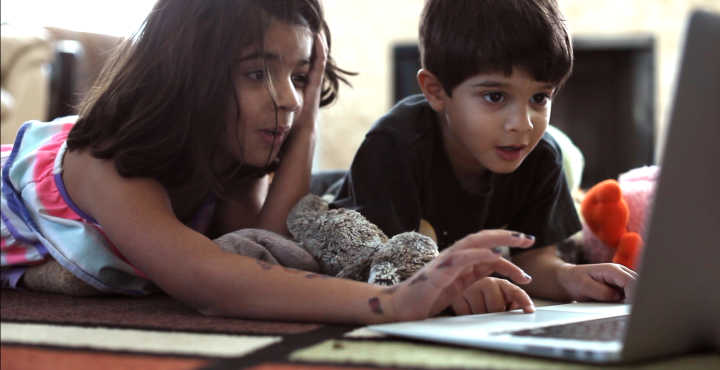Put Down That iPad! How We Get Our Kids Offline
Questions around screen time abound for parents! I want to share what WE do — in the Sewell McCann household, as well as within the families of the Sparkle Team — in hopes that it helps you with some of your own questions and challenges.
Because we have a wide range of ages within our team, I’m going to share the perspectives of our team in order of kids’ age.
Ready? Read on! I think you’ll come away inspired.
Jenny Barandich
Graphic Designer and Mom to two girls and a boy, ages 4, 7, and 13
The computer is a tool, not a toy. We have a limit on screen time for entertainment. During the screen time, kids can watch a movie or play, not both, about an hour a day.
We have this idea deeply instilled in my son that we're creators not consumers. So he prefers to make things (=draw, animate) not consume them (=play). It's a habit by now.
We parents are not scared of boredom – we see it as a springboard into something more fun and interesting. Since our kids know we won't be impressed by such complaints, they just find something to do.
We also don't do addictive games. All games are pre-screened by me and my husband. We spend tons of time outside.
KC Pagano
Media Curator and Mom to two girls, ages 7 and 9
Our motto is Body, Heart, and Mind. First, we have to take care of our bodies — i.e. good food, personal hygiene, exercise, nature time. Heart is family and friends time. Head time is where media can come in, after all the other options are filled. I ask that my kids read, make art, listen to stories, do lesson time. Then, after that, if they want to watch a short show or play a game picked by their dad, they can.
Susan Alexander-Wilson
Customer Care and Mom to a girl, age 9, and a boy, age 11
I must admit that our screen time rules are constantly evolving. We don’t know what we don’t know until it comes up! Our son worked over the summer to earn money to buy himself a phone, now that he’s in middle school. It’s only been two days that he’s had it, so we are navigating the rules and expectations around this. He’s not allowed to access social media, which certainly makes the phone less interesting to him.
We have a solid screen time cutoff every day, and the kids have to complete their homework and chores before they can even ask to turn on their devices. We don’t allow phones or devices at the dinner table and devices live in my room at night.
My daughter likes to get craft and recipe ideas from videos on YouTube Kids, and she listens to her Sparkle Stories every evening before bed.
My son likes to play word games and connect with friends through his XBox. He firmly believes we don’t let him have enough time with that. We feel like we let him have too much time. It’s a constant struggle.
I’m definitely looking to the rest of the team here for their wisdom on the subject.
Ann Boyd
Literary and Continuity Editor and Mom to two girls, ages 10 and 12
We’ve instituted a “token system,” inspired directly from a suggestion in Greg McKeown’s excellent book Essentialism (which is really about productivity, not parenting). Here is how we’ve modified McKeown’s system to work for our family.
Goals for our token system: - to increase reading and activity - to decrease unexamined screen time - to train children to manage their own screen usage
Details of our token system: - Each child receives ten tokens at the beginning of the week. - Tokens can be spent on screen time (one token = 30 minutes of screen time). - Tokens can be earned by reading or vigorous outdoor activity (30 minutes of reading or outdoor activity = one token earned). - Audiobooks (and Sparkle Stories!) count as “reading.” - Any remaining tokens at the end of the week can be exchanged for $0.50 each. - Watching movies together as a family does not require tokens.
To be honest, our system is imperfect. I don’t love the idea of rewarding kids for the pleasurable activities of reading and outdoor activity. However, I really like the way our kids are learning to manage their own screen time, which is a skill even most adults I know could benefit from developing.
Carla Cook
Marketing Director and Mom to two girls, ages 11 and 13
No phones at the table, including when we go out to eat, and all meals eaten together at the table. We have some great conversations then. We’re also big board game people and when weekend screen time gets out of control, we break for a couple of hours of games. I also just sometimes say “Phones off, books out.” They complain but only for a few seconds. :) Oh, and writing! I encourage them to grab a notebook and go crazy.
I’m also a huge proponent of music. It’s always on in our house and both the girls have an intelligence about artists and their different styles that is kind of shocking. I didn’t intend for that to happen — I’m just a music fan — so it’s a really pleasant surprise.
Lisabeth Sewell McCann
Sparkle CEO, and Parent with David Sewell McCann to two boys, ages 13 and 16
When Angus was born, I was so “no-media” that I wouldn’t even allow recorded sound in the house! (No music, no radio, no nothin’!) That’s how far I landed at the end of the media-use-spectrum, which I’ll admit now to give you some perspective.
(In fact, when we started Sparkle we were so low media we were nearly Luddites! It’s completely ironic that we went on to found an online business, except that we wanted to help families like us navigate the world of children’s online entertainment.)
We waited to introduce any screen time at home until our eldest was in third grade, when we invited him to watch the occasional movie. We had no TV throughout their early elementary years, and our computers were (mostly) in our office. As a Waldorf school family, this was a relatively easy thing to do, as our community and school encouraged and supported this choice. I can’t tell you how glad I am for it.
We waited to give our boys phones until seventh grade, and I would have waited longer except that our new life in Austin (and their level of independence in a big city) seemed to demand it.
Because we now have teenagers, our media rules are quite different than they were when our kiddos were young. They are also different between our two boys: our middle-schooler still has a contract with very specific rules, whereas our high schooler has fewer “rules”; instead we invite and encourage him.
I hope this has been as helpful for you as it has been for us — simply sharing our ideas and ways within our own team!
Not yet a subscriber? Try a free trial HERE.
About the Author

Lisabeth Sewell
Lisabeth Sewell has worn many hats at Sparkle over the years, from Sparkle Kitchen Blogger to Editorial Director to Doer of All Odd Jobs. Her primary role is as CEO.

